An effective search engine optimization (SEO) strategy is essential to the long-term success of any online business. Digital marketing channels such as advertising, social networking, emailing, affiliate marketing, and partnerships are all relevant, but in the long term, SEO is undoubtedly the most profitable and fruitful traffic lever for your business.
Today, in a time where there's often lots of competition for brands online, SEO is one of the main acquisition levers for the majority of website owners wishing to maintain and promote their online presence and gain market share. Ecommerce sites, showcase sites, blogs, news sites... All the various players on the web have now understood the importance of SEO, and everyone wants a piece of the pie.
How did we get here? What is SEO? What are the keys to success for boosting your website's rankings on the leading search engines and improving your SEO?
In this guide to search engine optimization, we explain everything from how search engines work to the pillars of SEO, as well as best practices for optimizing your website and tracking your results.
What does SEO mean and how does it work?
Search engine optimization covers the various processes and methods used to improve a site's ranking in search engine results.
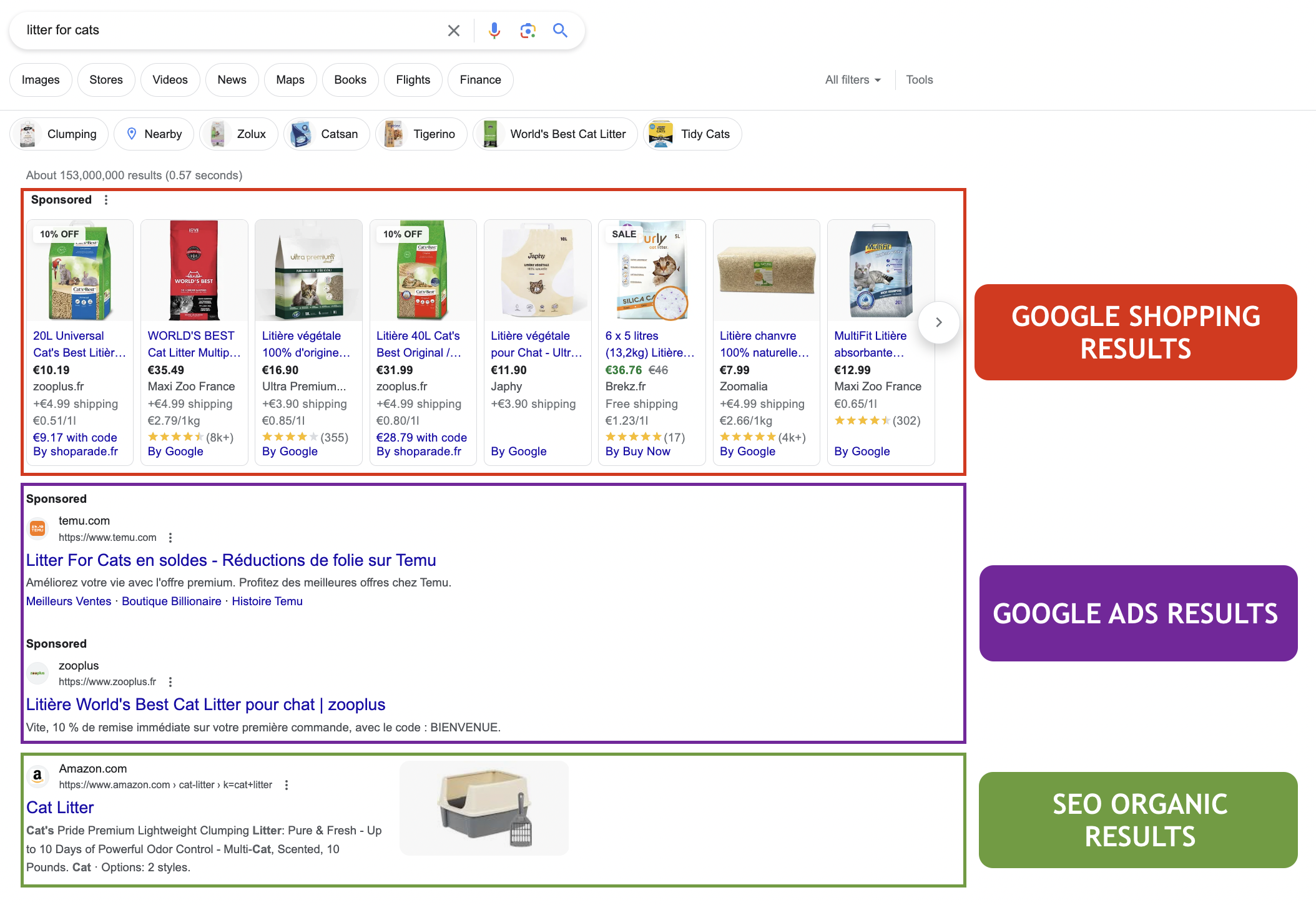
When you type "cat litter" into Google, the first items to appear are ads from Google Shopping, the second are ads from Google Ads, and then organic search results. These are the results of SEO work.
What are the advantages of SEO?
When it comes to all the different marketing strategies that brands have at their fingertips, SEO remains one of the most crucial, with its importance being due to several factors.
Organic search accounts for 53% of all site traffic (source: BrightEdge). With the majority of users visiting your website likely to come from organic search, it makes sense to do your best to understand it and devote time to working on building a strong SEO strategy and optimizing your content with this free marketing tactic.
I don't think that you'll find it surprising when I tell you that SEO has many advantages for every business on the internet. In fact, a 2023 survey by Statista that interviewed marketing professionals around the world determined that 82% of respondents stated that SEO had a positive impact on their organizations' marketing performance and objectives the previous year.
Here are some of the benefits to help you understand why SEO should be high on your list of priorities in terms of marketing strategies for your brand.
Visibility
Every day, billions of queries are typed into Google by users worldwide. If your pages are ranking well in the search engine results for subjects related to your theme, this ensures high visibility for your brand and greater brand awareness.
Traffic quality
A good SEO strategy involves knowing and targeting your target audience. By creating different pages featuring keywords and content that correctly respond to the searches of your personas, you attract qualified traffic interested in your products and services.
Savings
Marketing levers like search engine advertising (SEA) require a recurring and sometimes substantial advertising budget, depending on your sector. The queries you target with SEA today may be the ones you'll reach with SEO tomorrow. All the more reason to save money!
Conversion
Qualified traffic means conversions! The figures are unanimous: the conversion rate of SEO is one of the best. An internet user who has a specific purchasing intent and clicks on a page that perfectly meets their needs is particularly inclined to go ahead with the purchase and add the item to their shopping cart.
Sustainability
Once you've worked hard on your SEO and continue to feed your website regularly, you'll be driving traffic every day. Your pages will have every chance of maintaining good rankings over time. And that's what makes your business sustainable.
Revenue
This is, of course, the objective of SEO, and it's one you should never lose sight of! Above all, effective SEO enables you to attract qualified new customers, generate more sales, and increase your revenue.
User experience
SEO enhances user experience by ensuring that websites load quickly, offer easy navigation, and are mobile-responsive. By optimizing your site's content and structure, users find what they seek more efficiently. This, in turn, reduces bounce rates and increases user engagement, contributing to an overall better online experience.
How does a search engine work?
Before delving into the details of successful SEO, let's take a closer look at the fundamentals of the Google search engine.
In this guide, we focus on Google, the most widely used search engine worldwide (source: StatCounter), but you should be aware that other search engines such as Bing and Qwant work in the same way, apart from a few details.
How Google works
Google's operating principle is based on crawlers, also known as spiders, which explore and analyze the various URLs present on the web, before storing and displaying them to searchers. This mechanism can be simplified into three key stages.
- Exploration (crawling phase): Crawlers scan the web, moving from link to link in search of new URLs to explore and update. Each piece of information is collected and added to a listing (also known as an index) for later analysis.
- Indexation: Crawlers scan the web, moving from link to link in search of new URLs to explore and update. Each piece of information is collected and added to a listing (also known as a search index) for later analysis.
- Operation and distribution: Once the indexing stage has been completed, the surfer types a search into Google, and the algorithms carry out their analysis and interpretation work to display and rank the best possible results from among the billions of pages.
Universal search
The primary aim of a search engine is to provide the right answers to searchers on the internet, by displaying results that are both appropriate and of high quality.
Over time, search engines have evolved to provide ever more qualitative information, improving both rankings and search engine results pages (SERPs). Google is displaying an increasing number of elements in the results, to provide the most complete response possible to the web surfer.
In addition to the standard results, when you search the internet, you can discover elements from Google Shopping, Google Ads, Local Pack, Google News, Google Images, Answer Box, Knowledge Graph, People Also Ask, and Videos.
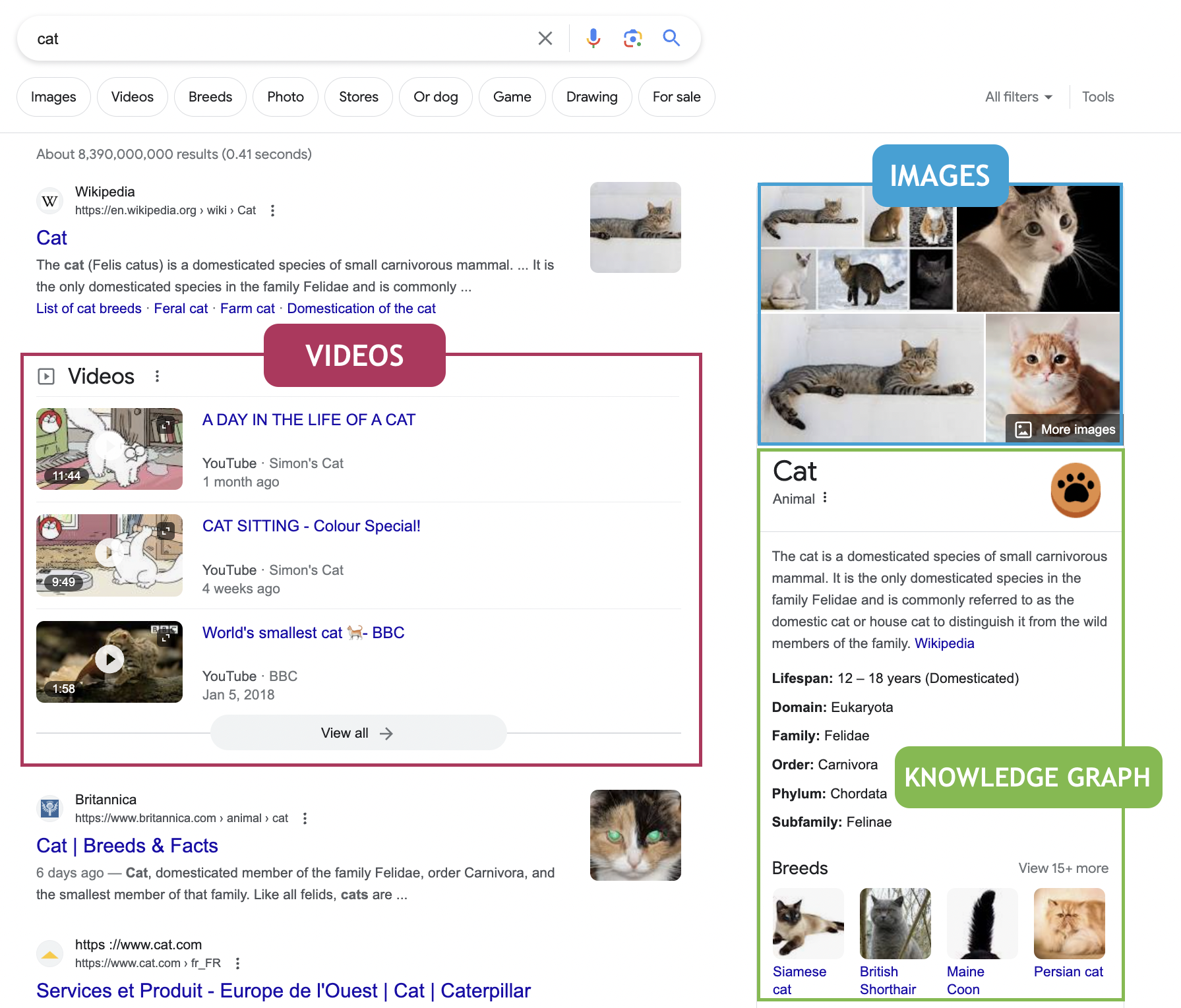
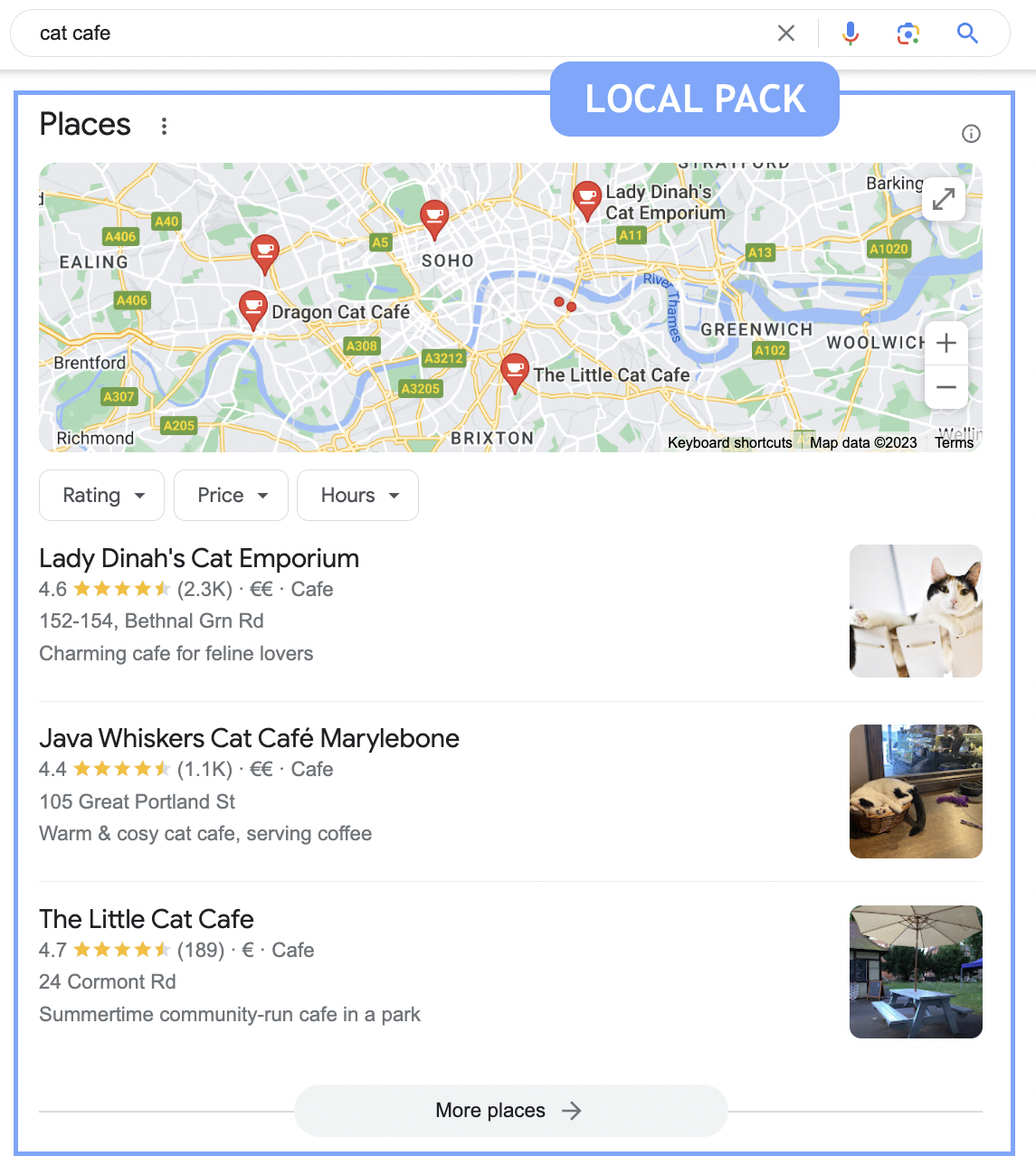
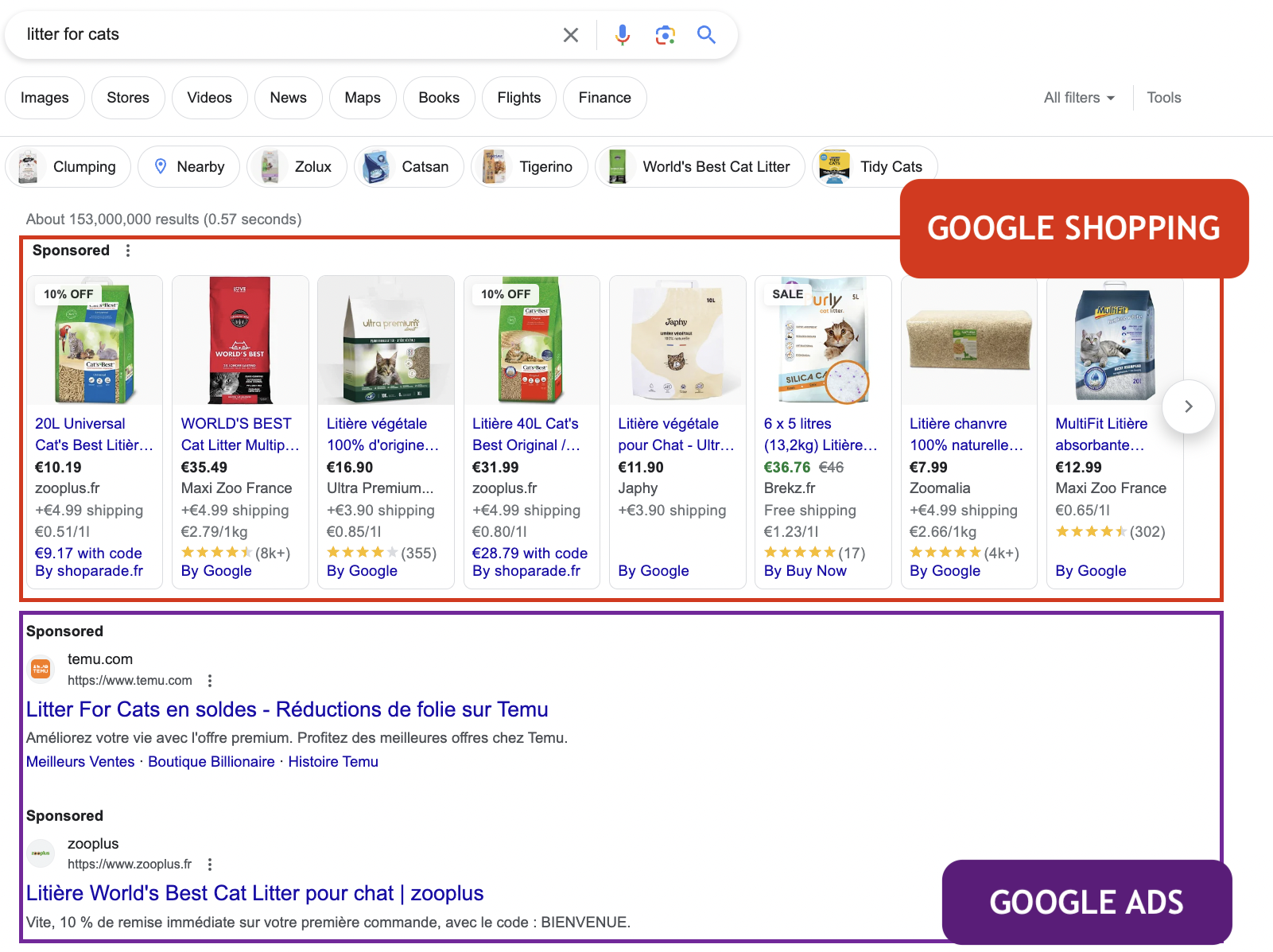
There's a growing interest in developing your different levers and supports in your SEO (Google My Business, videos, photos, etc.) to maximize your visibility.
Search intent
Continuing in the search results, based on the keywords you type in, the type of results will vary. Depending on the intent behind your search query, Google will display results that are adapted to your needs—which is pretty interesting!
This intent will determine the type of pages displayed in the SERP: homepages, category pages, product pages, blog posts, videos, etc.
Here are the kinds of search intent you need to know about:
- Navigational: The internet user is searching for a specific website or brand (e.g., "Décathlon").
- Informational: The internet user is looking for information (Example: "How do I wash a surfboard?").
- Transactional: The internet user wishes to purchase a product or service (Example: "Foam surfboard").
- Commercial: The internet user is looking for information about a product ("Best surfboard").
Here's an example to illustrate.
For the query "litter box for cats," Google displays results from Google Shopping and standard results with category pages. I can also see that the "Shopping" tab is placed at the top.
In this case, I'm dealing with a transactional intent. The person is looking for a product and has a real desire to buy.
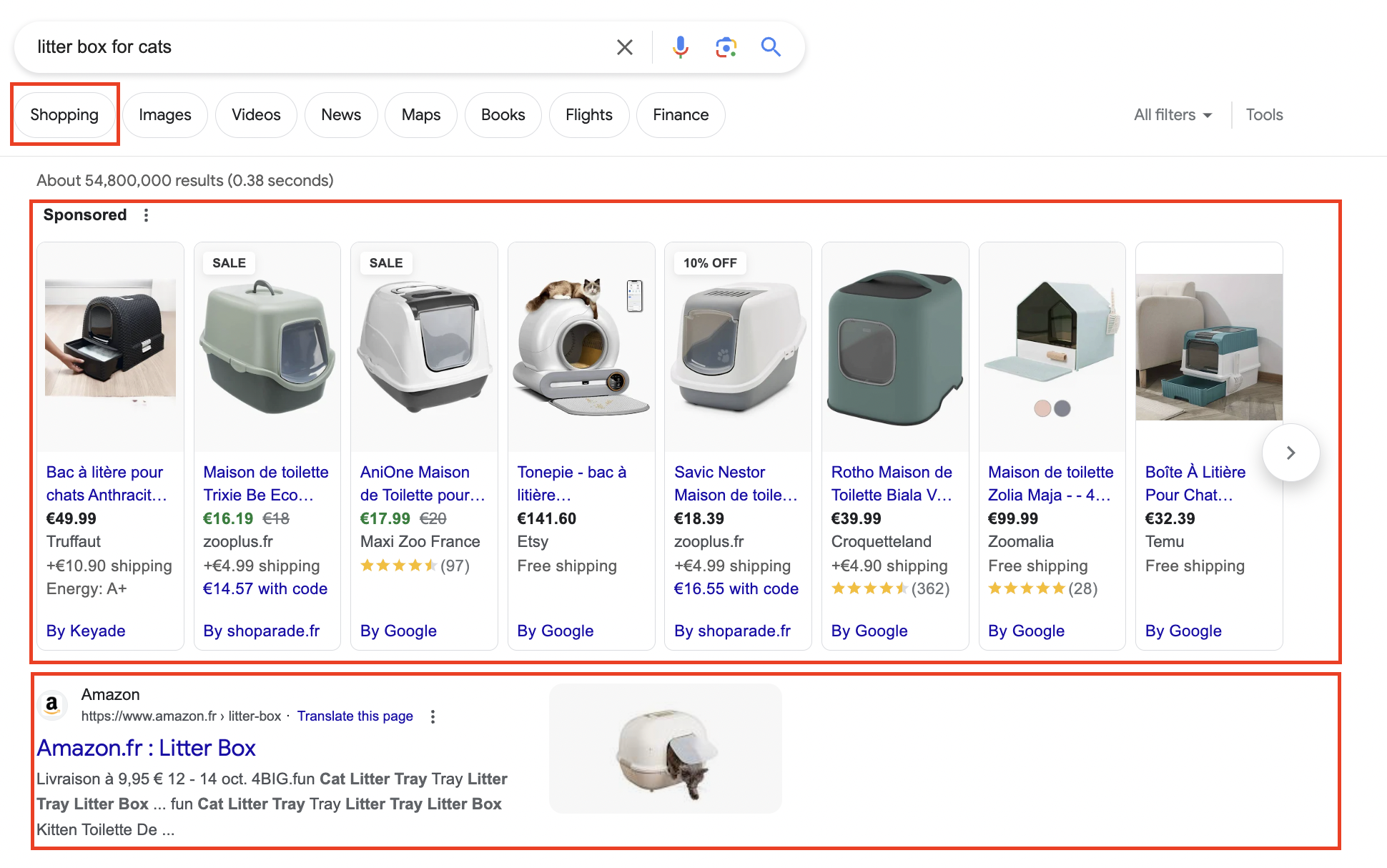
For the query "how to wash a cat litter box," Google displays an Answer Box, "People also ask" questions, standard results with blog articles, and videos. I can also see that this time, it's the "Videos" and "Images" tabs that are placed at the top.
In this case, the intent is informational. The person is looking for information.
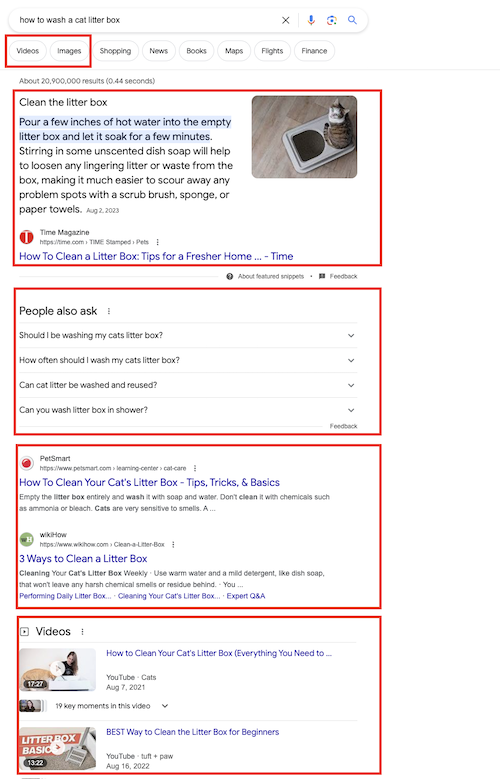
The bottom line behind search intent is that, depending on the keyword you're going to target, you'll need to carefully analyze the type of results to create an adapted page. Without this adaptation, it'll be virtually impossible to rank.
What algorithms should you know?
Knowing how search engines work is beneficial for understanding what's going on behind the scenes! To implement effective SEO, you also need to know the main algorithms and their particularities.
Among the popular algorithms that determine search rankings and ensure more relevant results, there are a few that have received a lot of attention.
Google Panda

Launched in February 2011 in the US, it tackles low-quality content, spam, content farms, and scrapers. The algorithm's mission is to cleanse search results of very low-quality content. The aim is always to ensure the best possible results for internet searchers typing queries into the search engine. To avoid the Panda filter, you need to focus on high-quality content that responds correctly to the search intent.
Google Penguin

Launched in April 2012, Penguin primarily targets website publishers who over-optimize link anchors from other websites (a link anchor is the text contained in a hyperlink). Faced with the strong presence of this technique and, above all, its effectiveness, Google was forced to integrate this algorithm into its search engine. Today, the key to increasing authority lies in acquiring high-quality links. To avoid the Penguin filter, you need to work carefully on your link building.
What are the three pillars of SEO?
To be displayed in the top results, you need to base your work on three main pillars. These are the SEO fundamentals that make up your strategy.
Content
Content is represented by everything that's present on the website: text, images, videos... Text remains the most important aspect of the page. It's what enables the search engine to understand your page and judge its relevance. Without content, a page is useless. It's also very important for the reader, who will find the information they're looking for in the text.
Technical optimization
Technical optimization involves the foundation of a website. It's made up of the page source code, server, various files (robots.txt, sitemap, CSS, JS, etc.), loading speed, HTTP responses, mobile compatibility, URL structure, etc. It's essential to check that crawlers can easily explore the various URLs relevant to indexing. The latest update linked to the technical information on the "Core Web Vitals" site proves Google's desire to highlight sites with good web performance and a good user experience.
Authority
Authority is essential for positioning your company's site in sectors that have a lot of competition. It's based on an authority score assigned to each page. This is made possible by the PageRank algorithm. For search engines, the more quality links a page has pointing to it, the more its authority will increase. I insist on the notion of "quality" because today, if you want to benefit from the full power of the backlinks you obtain by improving your ranking and avoid penalties, they must come from reliable and relevant sites.
How do you optimize and improve your SEO on Google?
Having a great-looking website is great, but without organic search traffic, there's little point! In this section, I'm going to share with you the various optimization techniques you can implement on your site to differentiate yourself from the majority of websites on Google. You can also feel free to use these specific elements to perform an audit and check the health of your site.
Technical base
As I mentioned earlier, the technical foundation of a site is an integral part of SEO. It has a direct impact not only on the crawling and indexing of your site, but also on the user experience for people visiting your site. It encompasses a whole range of factors and criteria that need to be verified, corrected if necessary, and monitored.
Among the key elements of the technical SEO lever, you'll find the robots.txt file, the sitemap, pagination, canonical tags, website breadcrumbs, structured data, etc.
Depending on the content management system (CMS) you choose, the technical structure is often chaotic, and it can be very complicated to apply corrective measures. That's why our WiziShop ecommerce solution responds to this problem by natively integrating a whole series of optimizations and technical improvements for users of the platform.
Discover the complete article that lists all of our SEO optimizations.
Try WiziShop free for 7 days
THE EASIEST NO-CODE ECOMMERCE SOLUTION✅ No credit card required
✅ Access to all features
✅ No commitment
Knowledge of your product and your persona
An effective SEO strategy must focus on the queries typed in by your target audience and on acquiring qualified traffic. For this reason, it's important to provide visibility on terms and expressions related to the products and services you offer.
It's therefore crucial to know your theme, your product and, above all, your buyer persona.
A strategy created on the basis of the target audience is the key to help you achieve effective ranking that generates sales.
Keyword research
Keyword research consists of analyzing, finding, and using the words and phrases typed in by your audience to search for your products and services. This key step enables you to better understand your persona and create relevant pages on specific subjects.
Keyword research involves several phases: brainstorming and then the analysis of keyword interest, competition, and search intent. To help you in this task, you can use a number of keyword research tools, such as Google Keyword Planner, Google Trends, and many others.
Site structure
Listing keywords gives you an overview of the different universes that revolve around your products and services. To create a site structure perfectly suited to your visitors and your theme, you need to group the different keywords together and prioritize them.
To help you map them out effectively, feel free to check out the MindMeister tool.
Based on your different groups, you'll then derive the site's menu, as well as the categories, subcategories, product pages, blog articles, and shopping guides to be created.
The site's structure is based on the notion of internal linking. This is one of the pillars of SEO. To find out more about the significance of internal links and using them effectively to help improve your rankings, head to our guide on internal links.
Page optimization
Now we come to one of the key elements in SEO: writing and content optimization. To write optimized texts, you need to follow a few best practices and fill in the tags correctly. These elements help to structure the web page and improve its comprehensibility for both internet users and search engines.
The title is one of the most important tags in SEO. This tag is displayed to users in search results and in the tab. It must be clickable, contain your keyword at the beginning of the text, and have the right number of characters/pixels.
The meta description tag is also displayed in search results. A meta description's content, however, isn't one of the ranking factors that's taken into account for SEO purposes, but it does have a certain value, as it encourages visitors to click on your URL.
URLs have very little impact on SEO, so I wouldn't recommend changing them if your website has already been online for some time. On the other hand, for your new pages, prioritize a short format with your main keyword, avoiding linking words.
This tag is different from the title tag. This title is displayed directly on the landing page, often at the very top. Also very important, you can differentiate it slightly from the title tag while keeping your target keyword inside.
The various tags at the heart of your page, such as H2, H3, H4, etc., allow you to structure your page by adding headings and subheadings. Remember to integrate your various keywords in a natural way and to prioritize them correctly.
- Paragraph
Paragraph tags correspond to the content you'll be writing within your different sections. Paragraphs are used to create text, respond to search intent, and enrich the lexical field to optimize your page.
Images are an integral part of your content. They can become a very beneficial source of traffic acquisition, especially in ecommerce. They must be unique, compressed, renamed before being added to your site, and have an ALT attribute.
Improvement in authority
Now that you know the various SEO actions to implement on your site to improve technical and content leverage, there's the third pillar: authority.
Authority is represented by all the links (or backlinks) pointing to your site. A backlink is a hypertext link integrated into a web page, which refers the visitor to a page on your site.
For search engines, the more quality links a page has pointing back to it, the greater its authority. I insist on the notion of "quality." To benefit from the full power of the backlinks you obtain and avoid penalties, they must come from reliable, relevant sites.
Improving authority requires a link-building strategy. There are several techniques to help you acquire backlinks: link baiting, directories, forums, guest blogs, partners, influencers, purchasing platforms, etc.
Google tools to improve your SEO and track your results
Like all marketing levers, you need to monitor the results of your SEO strategy to ensure its effectiveness. This monitoring involves the use of various tools.
Google Search Console
This is the essential tool for the vast majority of website publishers. Entirely free of charge, it's particularly useful for monitoring the indexing of your pages, monitoring the health of your site, tracking your SEO performance in Google, analyzing your backlinks, and much more!
Google Analytics
To improve your site and above all your conversions, you need to be able to measure traffic, know where it's coming from, and analyze your visitors' behavior. The Google Analytics tool will support you in your various KPI analyses and in the creation of your reports.
Google My Business
You may have a physical business or offer services in a specific catchment area. Local SEO is one of the major levers for attracting local customers. The tool for appearing in the Local Pack and Google Maps is Google My Business (GMB). Discover the complete GMB guide.
Depending on your needs and skills, there are of course a whole host of other free and paid tools for you can use throughout the process of working on your site's SEO that don't belong to Google.
Whether for auditing, keyword research, backlink analysis, rank tracking, semantic optimization, or log analysis, each tool has its own specificity!
To name but a few: Semrush, Ahrefs, Ubersuggest, YourTextGuru, Screaming Frog, Semji, SEObserver, Monitorank, AnswerThePublic, Majestic SEO, and many more!
How long can you expect SEO to take for your website?
You now have all the information you need to implement an effective SEO strategy for your site. To make sure you don't get any surprises from the Google search engine, always think of users when working on your site, and keep your authority strategy as "natural" as possible.
Finally, I haven't directly mentioned it in this guide, but one of the pain points that people experience with SEO is that it's a process that takes time. Unlike paid search with Google Ads, for example, you won't see results with organic search overnight. You'll need to be patient and work steadily over a period of months or years. Once SEO starts delivering results, your business will enter a new dimension!
Try WiziShop free for 7 days
THE EASIEST NO-CODE ECOMMERCE SOLUTION✅ No credit card required
✅ Access to all features
✅ No commitment


![Search engine optimization: Guide to getting started in SEO [2026]](https://wizishop.com/media/652695f6a56cb001dd296db3/v1/search-engine-optimization-wizishop.jpg)







